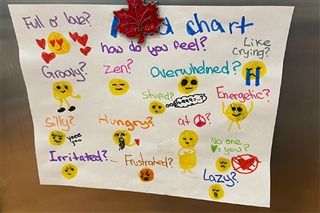What is the difference between a feeling and an emotion? Many use the terms interchangeably. In very simplistic terms, emotions are physical and instinctive and their general purpose is to produce a specific response to a stimulus. Emotions include fear, anger, joy, sadness and disgust (like the main characters from the Pixar movie Inside Out). Feelings, on the other hand, are mental associations and reactions to an emotion that are personal and acquired through experience. Feelings include happiness, love, worry, contentment and bitterness. In a nutshell, the emotion comes first and is universal. What kind of feeling(s) it will then become varies enormously from person to person and from situation to situation because feelings are shaped by individual temperament and experience. For simplicity and for the purpose of this activity, I will refer to feelings. When it comes to how we feel, we “name it to tame it”. The next step is to understand why we are feeling this way. If we can feel the feeling without creating a story or attach a narrative to it, we can ride the waves with more ease. Feelings indicate what is important to us and are valuable tools in understanding what we need in that particular moment. Often, especially with children, the need is to feel connected, heard, seen, loved and worthy. Our current global circumstances mean that we are spending more time together in confined spaces. As I began to witness the level of tension building, I wanted to find a tool in which my children could take ownership for navigating their own feelings. To encourage their “buy in” to commit to daily check-ins for their feelings, I encouraged them to create a feeling chart for the family. My daughter and son spent hours collaborating together—identifying what they believe to be “core” feelings. They had fun creating and drawing the corresponding emojis. We placed their charts on the fridge as a constant reminder for us to check-in with ourselves and with each member of the family throughout the day.As a parent, I have noticed how this tool has benefited our family dynamics. It has created accountability. Each person is accountable for saying “hey, I’m feeling not heard ” right now.” Or, “I’m feeling frustrated right now because ______”. There is more initiative to identify and voice the feeling. In addition, each member is expressing why they feel that way. Oftentimes, it is challenging for children to express the why—perhaps they do not know why or they do not want to voice it out loud. Being able to point to an emoji has become a significant part of our day and the why is now identified and shared easily and voluntarily from each of us! The feeling chart has also built empathy between each family member. There is genuine concern over how each person is feeling and a desire to listen to the why. Most importantly, the feeling chart has brought more awareness about what the feeling is trying to show us in the moment. I invite you to try this with your family and have fun creating your own unique charts!

Related Posts

Celebrating Gavin Bowers’ 35 Years at GNS
There’s no mistaking the positive impact that Gavin Bowers, Junior School Vice Principal, has had on GNS. His energy...

Six Reasons to Host Setagaya Students this Summer
This summer, Setagaya Gakuen School (SGS) is planning to once again send students to visit Glenlyon Norfolk School. Since...

GNS Prepares for Spectacular Lunar New Year Celebration on February 8
Anticipating the Lunar New Year on February 8, the GNS community is preparing for an extraordinary celebration, propelled by...

